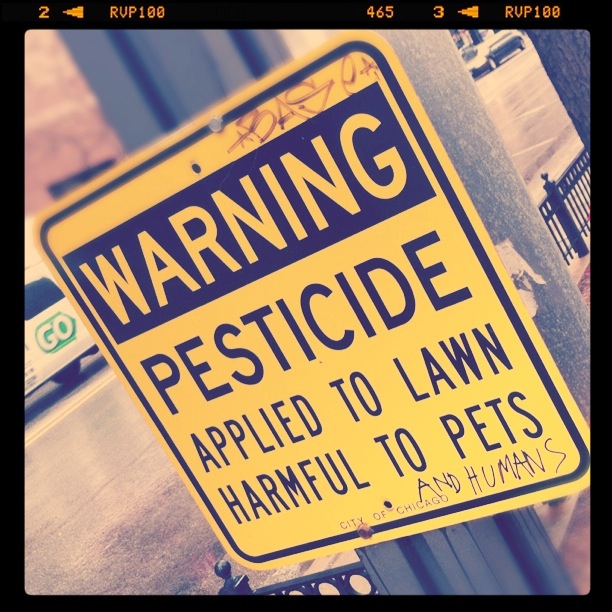I recently contacted the Scott’s Company to find out how long would it be after the last use of its “Weed n’ Feed” hericidal lawn product, before it would be safe to allow chickens onto such grass? This was a question, Urban Chicken Podcast Listener, Susan, posed to me and I couldn’t seem to find the answer in my own independent research. So I went straight to the source and asked Scott’s customer service representative Susan’s question using the information she provided me.
Here is the transcript of my on-line customer service chat that I had with Scott’s Company representative, Amanda.
Chat Transcript
info: Please wait for a site operator to respond.
info: You are now chatting with ‘Amanda’
Amanda: Hello, how may I help you today?
Jen: Dear Scott’s: My husband used your weed and feed product on our lawn and the warning label on the product said, “this product is not intended for use where grazing animals such as chickens are.” We now own chickens and I am not sure what to do. His last application was about two weeks ago. When will my yard be safe for the chickens to roam around in?
Jen: What is the half-life of the dangerous chemicals in your product for my chickens and ultimately for us eating their eggs?
Amanda: Animals should not graze for a year after the application. We have no information about when it is safe for them to return. The herbicides aren’t registered for use where animals will be grazing.
Jen: Is there any information when the treatment is essentially “Gone”? You mentioned a year – where did that length of time come up?
Jen: I’m hoping Scott’s company might have some resource for me to look at to figure this issue out.
Amanda: that is when it can be assumed that there would be no product left in your soil. While the ingredients have a half life of less than that timeframe, its impossible for us to say when exactly it is safe for them to return. When talking about the health and safety of people and animals, its necessary that we be sure the area is 100% safe for reentry.
Amanda: What type of resource are you looking for?
Jen: I was hoping for a brochure or something that might tell me the time frame when the product’s chemical’s would be gone.
Amanda: I can see what I can find for you.
Jen: Thank you
Amanda: Unfortunately I don’t have any literature on that subject.
Jen: If I dig up the grass, would the dirt beneath be safe for the flock’s run?
Amanda: There is no way to neutralize the application. Let me contact my supervisor to see if I can find additional information.
Amanda: You can remove the soil, but you’ll need to go 2 inches below the moisture line. That could vary based on your specific soil. It could be a foot or more.
Jen: What is the moisture line?
Amanda: It varies. I’m trying to get more information for you.
Amanda: There should be a kit you can purchase at a hardware store. It will tell you how to find out how deep you’ll have to go. It’s fairly extensive. And it will have to be replaced with new soil.
Amanda: Okay, It’s called a Moisture Sensor/Meter/Hydrometer/Soil Water Monitor. It’s something very long that you shove into the ground, and it will tell you when you’ve reached an area that is dry.
Jen: Thank you for that information. I have another question.
Amanda: Sure, how can I help?
Jen: Since the Scott’s company does not have a brochure or any resources for its customers to rely upon to determine the half-life of their products for chickens, could you tell me which of the chemicals listed would be the ones that I should particularly worry about with my chickens. If I knew which of the chemicals are the ones I need to particularly be concerned about for my hens then I could independently research about the half-lives of those particular chemicals?
Amanda: I can tell you the half life for each chemical – however, these chemicals are not registered for use around grazing animals by the EPA.
Jen: That would be helpful
Amanda: I will get you that information. However, for the safety of your chickens and those consuming their products, you’re really best to not allow them to return.
Amanda: The half-life of 2,4-D in soil, is less than 7 days
Amanda: MCPP half life is 2-3 weeks.
Jen: Are there any other chemicals besides those?
Amanda: Those are the two chemicals in the product.
Amanda: But neither of them have been determined safe in any grazing pasture/grss.
Jen: Thank you for that information and warning.
Jen: I must admit that I agree with you that I want my animals and family to be 100% safe on our lawn and Scott’s doesn’t have “information about when it is safe for them [chickens] to return.” I would think that this would be a common question that Scott’s would be able to answer more definitively.
Amanda: The answer, unfortunately, is a year. That is an EPA regulation.
Jen: I am rather disconcerted by the situation I find ourselves in.
Jen: Thank you for your assistance.
My conversation with Amanda at Scott’s just reaffirmed my already held belief that the commercially available lawn products that are commonly sold and used in American yards across the nation are more toxic (and their toxicity lingers longer) than we would assume.
There are organic options to lawn care available everywhere – for the health of your chickens and your family, I suggest switching to something that is safe.
SUPPORT THE URBAN CHICKEN PODCAST:
- Support the Urban Chicken Podcast by shopping Amazon starting here: Amazon
- If Amazon is not your thing – you could also support the show HERE

